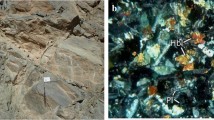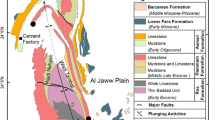Abstract
P-wave velocity is one of the non-destructive geophysical methods directly or indirectly used by engineering working by various filed. Thus the accuracy of the recorded P-wave velocity affects these parameters. In this survey whether the sample dimensions measured in laboratory have effect on P-wave velocity or not was investigated. Nine different rock groups were used in this study. Six different diameter core samples were prepared from each of the groups. Ultrasonic tests were carried out on the core samples having different diameter to investigate how the sound velocity varies with sample dimension. The test results were statistically analyzed using the method of least squares regression, exponential, and polynomial relationship with high correlation coefficient were found between the sample diameters and P-wave velocities. In four sample groups a decrease in ultrasonic velocity depending on an increase in diameter was observed. In five other sample groups in the samples up to 78.68 mm diameter, a decrease in P-wave velocity value was observed but a significant increase in the P-wave velocity was observed for the biggest diameter samples. This observed decrease connected with sample dimension varies dependently on physical characteristic properties of the sample.
Similar content being viewed by others
References
Knill, T.L.: The application of seismic methods in the interpretation of grout takes in rocks. In: Proc. Conf. In Situ Investigation in Soil and Rocks. British Geotechnical Society, vol. 8, pp. 93–100. (1970)
Turk, N., Dearman, W.R.: Assessment of grouting efficiency in a rock mass in terms of seismic velocities. Bull. Int. Assoc. Eng. Geol. 36, 101–108 (1987)
Price, D.G., Malone, A.W., Knill, T.L.: The application of seismic methods in the design of rock bolt system. In: Proc. First Int. Cong. Int. Assoc. Eng. Geol., vol. 2, pp. 740–752 (1970)
Young, R.P., Hill, T.T., Bryan, I.R., Middleton, R.: Seismic spectroscopy in fracture characterization. Q. J. Eng. Geol. 18, 459–479 (1985)
Turk, N., Dearman, W.R.: A suggested approach to rock characterization in terms of seismic velocities. In: Proc. 27th 268 US Symp. Rock Mech., pp. 168–175 (1986)
Ondera, T.F.: Dynamic investigation of foundation rocks, in situ. In: Proc. 5th 252 US Symp. Rock Mech., pp. 517–533 (1963)
Gladwin, M.T.: Ultrasonic stress monitoring in underground mining. Int. J. Rock Mech. Min. Sci. 19, 221–228 (1982)
Hudson, J.A., Jones, E.T.W., New, B.M.: P-wave velocity measurement in a machine bored chalk tunnel. Q. J. Eng. Geol. 13, 33–43 (1980)
Karpuz, C., Pasamehmetoglu, A.G.: Field characterization of weathered Ankara andesites. Eng. Geol. 46, 1–17 (1997)
Dearman, W.R., Turk, N., Irfan, Y., Rowshanei, H.: Detection of rock material variation by sonic velocity zoning. Bull. Int. Assoc. Eng. Geol. 35, 3–8 (1987)
Boadu, F.K.: Fractured rock mass characterization parameters and seismic properties: analytical studies. J. Appl. Geophys. 36, 1–19 (1997)
Kahraman, S.: The effect of fracture roughness on P-wave velocity. Eng. Geol. 63, 347–350 (2002)
Kahraman, S., Soylemez, M., Fener, M.: Determination of fracture depth of rock blocks from p-wave velocity. Bull. Eng. Geol. Environ. 67, 11–16 (2008)
D’Andrea, D.V., Fisher, R.L., Fogelson, D.E.: Prediction of compressive strength from other rock properties. In: US Bureau of Mines Report of Investigation 6702 (1965)
Deer, D.U., Miller, R.P.: Engineering classification and index properties for intact rock. Air Force Weapons Lab. Tech. Report, AFWL-TR 65-116, Kirtland Base, New Mexico (1966)
Youash, Y.: Dynamic physical properties of rocks: Part 2. Experimental result. In: Proc. 2nd Congr. Int. Soc. Rock Mech. Beograd, vol. 1, pp. 185–195 (1970)
Saito, T., Mamoru, A.B.E., Kundri, S.: Study on weathering of igneous rocks. Rock Mech. Japan 2, 28–30 (1974)
Gardner, G.H.F., Gardner, L.W., Gregory, A.R.: Formation velocity and density: the diagnostic basis for stratigraphic. Geophysics 39, 770–780 (1974)
Lama, R.D., Vutukuri, V.S.: Handbook on mechanical properties of rocks. Trans. Tech. Publ., 2 (1978)
Inoue, M., Ohami, M.: Relation between uniaxial compressive strength and elastic wave velocity of soft rocks. In: Proc. Int. Symp. Weak Rock (Tokyo), pp. 9–13 (1981)
Gavilio, P.: Longitudinal waves propagation in a limestone: the relation between velocity and density. Rock Mech. Rock Eng. 22, 299–306 (1989)
Sisman, H., Altıntas, M., Ozturk, İ.: Relationships between seismic wave velocities and rock parameters in rock mechanics. In: 2th National Rock Mechanics Symp., Ankara, 5–7 November, pp. 221–237 (1990)
Boadu, F.K.: Predicting the transport properties of fractured rocks from seismic information: numerical experiments. J. Appl. Geophys. 44, 103–113 (2000)
Yasar, E., Erdogan, Y.: Correlation sound velocity with density, compressive strength and Young’s modulus of carbonate rocks. Int. J. Rock Mech. Min. Sci. 41, 871–875 (2004)
Kahraman, S., Soylemez, M., Gunaydin, O., Fener, M.: Determination of the physical properties of travertines from ultrasonic measurement. In: International Travertine Symposium & Technologies Exhibition, Pamukkale University, Denizli, Turkey, September 21–25 (2005)
Kahraman, S., Ogretici, E., Yeken, T., Fener, M.: Predicting the physico-mechanical properties of igneous rocks from electrical resistivity measurements. In: Eurorock’06, European Regional ISRM Symposium, Liege, Belgium, 9–12 May (2006)
Kahraman, S., Yeken, T.: Determination of physical properties of carbonate rocks from P-wave velocity. Bull. Eng. Geol. Environ. 67, 277–281 (2008)
Kahraman, S., Gunaydin, O., Fener, M.: Predicting the uniaxial compressive strength of pyroclastic rocks from the P-wave velocity. In: Sixth International Symposium on Geophysics, Tanta, Egypt, 11–12 November, 27p. (2009)
Wyllie, M.R.J., Gregory, A.R., Gardner, G.H.F.: An experimental investigation of factors effecting elastic wave velocities in porous media. Geophysics 23, 459–493 (1958)
Till, R.E., Bur, T.R.: An automated ultrasonic pulse measurement system. Geophysics 34, 101–105 (1969)
Nur, A., Simmons, G.: The effect of saturation on velocity in low porosity rocks. Earth Planet. Sci. Lett. 7, 183–193 (1969)
Ramana, Y.V., Venkatanarayana, B.: Laboratory studies on Kolar rocks. Int. J. Rock Mech. Min. Sci. Geomech. Abstr. 10, 465–489 (1973)
Wang, C., Lin, W., Wenk, H.: The effect of water and pressure on velocities of electric wave in a foliated rock. J. Geophys. Res. 80, 1065–1069 (1975)
Gregory, A.R.: Fluid saturation effects on dynamic elastic properties of sedimentary rocks. Geophysics 41, 721–895 (1976)
Kahraman, S.: The correlation between the saturated and dry P-wave velocity of rocks. Ultrasonics 46, 341–348 (2007)
Donath, F.: Experimental study on the shear failure of anisotropic rocks. Geol. Soc. Am. Bull. 72(6), 985–990 (1961)
Piniska, J.: Correlation between mechanical and acoustic properties of flysch sandstones. In: Int. Symp. on the Geotechnica Italiana, Capri, vol. 1, pp. 387–394 (1977)
ISRM: Rock characterisation testing and monitoring. In: Brown, E.T. (ed.) Pergamon Press, Oxford (1981), 211 pp
ASTM: Standard method for laboratory determination of pulse velocities and ultrasonic elastic constant of rocks. Annual Book of ASTM Standard, Pert 19, D. 2845-69:356–363 (1978)
Author information
Authors and Affiliations
Corresponding author
Rights and permissions
About this article
Cite this article
Fener, M. The Effect of Rock Sample Dimension on the P-Wave Velocity. J Nondestruct Eval 30, 99–105 (2011). https://doi.org/10.1007/s10921-011-0095-7
Published:
Issue Date:
DOI: https://doi.org/10.1007/s10921-011-0095-7




